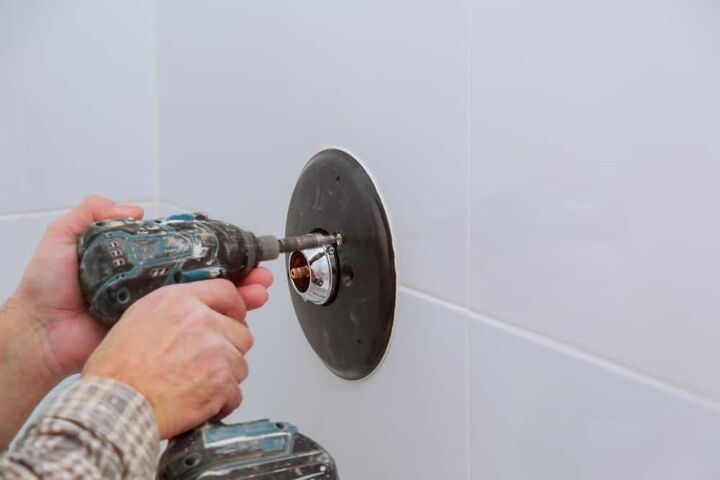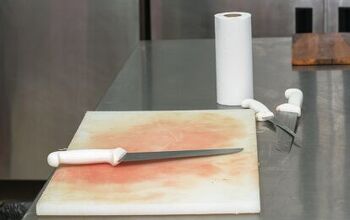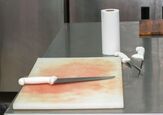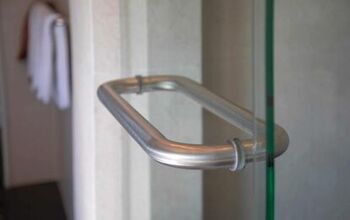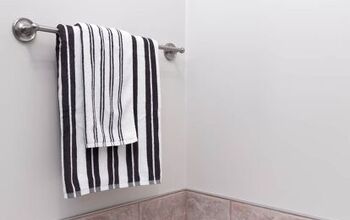How To Remove A Stripped Screw From A Shower Faucet (Do This!)

Every now and again, repairs need to be made around the home. The bathroom is one of the more common areas in need of repairs, oftentimes in the sink, bathtub, or shower. Knowing the best ways to tackle those repairs can mean the difference between a successful repair and one that carries on for way longer than it needs to.
One such problem is while trying to remove the shower faucet or the faucet handles. The screws can get stripped out, making the removal process that much more difficult. To get a stripped screw out, you will need to drill out the center of the stripped screw. With the right tools, the process is relatively easy.
Do You Need a Faucet, Fixture, or Pipe Repair or Replacement?
Get free, zero-commitment quotes from pro contractors near you.

Removing a Stripped Screw from a Shower Faucet
Step 1: Cobalt Drill Bit
You will generally need two or three tools to get this job done. The third is optional (some kind of screw extractor) but can certainly make the final step easier. Other than that, you need a drill and a cobalt drill bit.
Take that cobalt drill bit and insert it into your drill. The bit diameter should be just big enough to fit into the head slot on the screw. In 99 out of 100 instances, the set screw will either be an Allen-head screw or a Phillips-head screw. Your cobalt bit should be large enough that it just fits inside of the head of the stripped screw.
Step 2: Drill
Now that you have the proper cobalt drill bit, it is time to drill out the center of the head. Drill through the head’s center just enough so that the bit passes through the bottom of the head of the screw. Don’t just torque down here; apply a little bit of caution and patience.
When you have passed the bottom of the screw head, you will need to swap out bits. Remove your current cobalt bit and swap it out for one that matches the screw head’s diameter. The closer you can get to that diameter, the better the result.
Step 3: Drill Out the Head
With your bits swapped out, it is time to drill out the head of the stripped screw. Position your drill over the hole that you created in the previous step. Begin drilling out the screw head. This may take a little bit of patience, so don’t be surprised if you aren’t done in seconds.
Continue drilling into the stripped screw head until you just barely reach the handle’s inside diameter. Try to move slowly and patiently to ensure that you don’t overdo it. When you this point, pop out your drill bit from the handle.
Step 4: Remove the Faucet Handle
You should now be able to pull on the faucet handle, moving it away from the faucet itself. If it doesn’t come off cleanly, don’t worry. There is a chance that you might have to jiggle the handle a bit in order to break it free. The handle can get stuck on some of the small slivers created from drilling the set screw.
You can also use locking pliers to help twist the faucet off of the stripped screw. The better the grip that you have on the faucet, the easier it will likely be to remove it. It is up to you and what tools you have available.
How To Remove Stripped Screws
4 Other Ways to Remove a Stripped Screw
Unfortunately, drilling out a stripped screw in your shower is unlikely to be the only time that you deal with that inconvenience. Plenty of things in our lives use screws of all kinds. And from time to time, those screws will get stripped out and seem impossible to remove.
The good news is that you can reduce it to a minor annoyance. There are a few helpful tips that can get that stripped screw out and get you back on track in no time. Even better, some of these tips require nothing more than a few household items to pull off.
Use Rubber Bands to Remove a Stripped Screw
Did you know that you can remove a stripped screw with nothing more than a rubber band and your drill? That’s right, it really can be that simple. Here’s the process of removing a stripped screw with a rubber band:
- Put the rubber band over top of the stripped screw. The purpose of the rubber band is to give your drill something to grip onto since the screw (which would normally do that) has been stripped out. All you need to do is lay your rubber band down over the stripped out screw.
- Slowly unscrew. With your rubber band in place, position your drill (a screwdriver could work, too) so that the point is pushing down on the surface of the rubber band. Turn the drill or screwdriver slowly and the stripped out screw should start to turn with it.
- No rubber band? Try this. If, for whatever reason, you don’t have any rubber bands laying around and don’t want to go to the store, don’t worry. You can swap out some steel wool or even the abrasive side of a kitchen sponge instead.
Drill Out a New Hole
This is very similar to the “how-to” from above, with a minor difference: you shouldn’t need anything to pull the stripped out screw off other than your drill. The concept here is to drill into the stripped out screw so that your drill has something better to grip onto.
Just make sure that you use a bit designed for drilling into metal instead of wood. It is also important that you not drill too far into the stripped out screw. If you go too far, the head of the screw could pop off, making it more difficult to remove the body. Drill just far enough that you can get the original bit further down to achieve a better grip.
Try Pulling it Out with Pliers
Keep in mind that this step will really only work if you see any daylight between the head of the stripped screw and the surface where it is fastened. If you don’t see daylight, the screw hasn’t been loosened at all and another method will be required.
Should you see daylight, then there are two steps for getting the stripped screw out using pliers:
- Try to get a grip. Use your locking pliers (aka vise grips) to see if you can get a good grip on the screw. If you can’t really grab hold of it, move on to another method for getting the screw out. This will likely just leave you feeling frustrated and won’t get the results you are looking for.
- Twist and pull. Depending on how embedded the screw is and how severely it is stripped, this part can vary. When you have a firm grip on the screw, you should be able to either pull the screw out or slowly turn it. Keep working at it until you can finally remove the screw from the surface.
This method might take a little more grunt work than some of the others out there, but it generally works pretty well. So long as you can turn the screw, it should eventually come out of the material where it rests.
Do You Need a Faucet, Fixture, or Pipe Repair or Replacement?
Get free, zero-commitment quotes from pro contractors near you.

If the Head is Phillips, Use a Flat Head
The vast majority of screw heads out there tend to be of either the Allen or Phillips variety. So, if you are staring down a Phillips head screw that just won’t turn, try reaching for your handy flat head screwdriver instead.
The flat head should be just narrow enough that it will fit into the hole of the Phillips-head. The caveat here is that it will take a little bit of elbow grease to make this work. If you really want to find an effective strategy, bring the rubber band into play.
By introducing the rubber band, you should create a more effective grip for your screwdriver. You can also use your hammer to tap your screwdriver so that it permeates the head of the stripped out screw, allowing for a far greater grip than before.
Related Guides

Ryan Womeldorf has more than a decade of experience writing. He loves to blog about construction, plumbing, and other home topics. Ryan also loves hockey and a lifelong Buffalo sports fan.
More by Ryan Womeldorf



